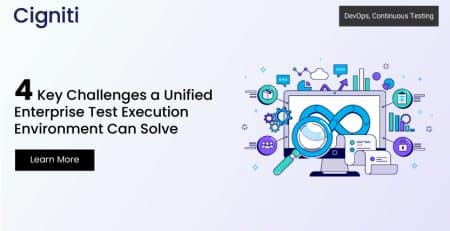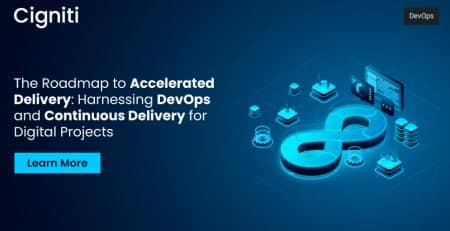7 Key Takeaways from Cigniti-LambdaTest Digital Dialogue Fireside Chat
Businesses today need to deliver top-notch software at lightning speed. To achieve this, they are incorporating DevOps practices to accelerate their software development and Continuous Testing practices to test early and test often to provide quality software. However, DevOps and Continuous Testing are implemented in many organizations using separate tools and environments, leading to inefficiencies, delays, and increased costs.
In this context, Cigniti recently held a digital dialogue fireside chat with the leading industry experts from NelsonHall, LambdaTest, and the industry expert from Cigniti. The panelists discussed extensively the challenges, innovations, and strategies to simplify the testing landscape for enterprises.
This blog delves into seven key takeaways from the recently held digital dialogue fireside chat.
1) Executive sponsorship, employee buy-in, and committed vendor
DevOps and Continuous testing are the key activities in many leading enterprises. Deploying DevOps tools, incorporating test frameworks, re-skilling, and rescaling are happening in this background. But the three important things that help the enterprises are executive sponsorship, employee buy-in, and a committed transformational partner. Any significant transformation happening within a company needs enormous support from the executive. Adopting new tools and processes, re-skilling employees, and scaling the organization with new processes are essential. Employee buy-in is critical in moving the enterprise from point A to point B. Incentivizing the testers and IT staff to adopt new technologies and re-skill themselves is crucial to break the barrier of using old technologies. A committed vendor like Cigniti drives the change and acts as a catalyst for the company’s success.
2) Need for Unified Enterprise Test Execution Environment
The whole movement of DevOps transformation and agile way of developing software has accelerated many folds. Over the last three to four years, one of the biggest drivers of this has been the DevOps platform’s consolidation. What is happening now is combining DevOps and Continuous testing on a single platform. Earlier teams used to develop the complete software and then start testing. This moved to continuous testing as you started developing the software. But as the software is being built, the quality runs and checks need to happen quickly. This brings in the need for Unified Test Execution Environments for enterprises.
3) Quality-by-all and quality-for-all approach to testing
Quality should be at the center of the software delivery life cycle. The requirements that are getting designed, the software that is getting developed, and the components produced for the end user should have the same passion for quality. Engineering a solution can be possible by learning a tool, integrating a tool with another, writing the next level of code with efficiency, etc. All this is tangible and learnable, but the cultural shift should happen towards quality first mindset. At the enterprise level, it must be quality by all and a for-all approach. Most enterprises still look at quickly putting features into production rather than ensuring quality.
4) Just-In-Time Test Orchestration (JITTO)
Inspired by a six-sigma supply chain concept, Just in Time Test Orchestration helps streamline the testing process. JITTO requires having the components and resources available when you need them to move the process forward. The whole software development process, continuous development, continuous testing, continuous integration, and continuous deployment is a form of the supply chain which keeps happening repeatedly. During the development process, multiple servers are used which leads to an increase in the cost of doing the business. JITTO helps by optimizing the resources, simplifying the software development process, reducing the overhead costs, and providing visibility into what tools and frameworks the teams are using in a single environment. Using JITTO, the frameworks, and tools are available to the teams just in time and need not wait for the processes to be set up from scratch in different environments.
5) Role of leadership in successfully implementing DevOps and Continuous testing
Leadership is important in providing vision and strategy to the entire ecosystem. Whenever a change happens, there is a lot of resistance. The leadership must focus on three aspects to implement the change successfully: collective decision-making, a culture of collaboration, and collective ownership. Involving the employees in the decision-making process of selecting the tools, incorporating a culture of collaboration within the teams, and providing the right KRAs to build in the collective ownership is necessary for handling the change smoothly and effectively. On top of this, leadership must provide for the ecosystem whenever and wherever anything is required. Be it optimization of budgets, recruiting the necessary human resources, etc. We must also have collective monitoring and governance mechanisms around these three aspects.
6) The future of DevOps, Continuous Testing, and the use of AI tools
Unified environments are going to be very useful in DevOps and Continuous testing. Having so many execution tools and testing frameworks makes it harder for enterprises to deliver software efficiently. A unified platform can bring together all tools and frameworks into a single environment. This helps in managing the SDLC with flexibility and ease. Enterprises started using AI tools for the creation of test scripts and maintenance. This significantly reduces the time for generating test scripts and testing the software. But the future is exciting when we look at AI-based automation of testing.
7) The benefit of integrating iNSta™ by Cigniti and Hyperexecute from LambdaTest
Cigniti’s iNSta is an IP-led scriptless test automation tool that aims to democratize the test automation process at the enterprise level. LambdaTests’ Hyperexecute is an AI-powered, blazing-fast end-to-end test orchestration cloud. With the integration of these two platforms, we have an intelligent scriptless test automation tool that works at blazing speed, thus providing a faster time to market for enterprises across the globe.
In summary, the digital dialogue fireside chat provided rich insights on DevOps and continuous testing challenges and how to tackle them, the importance of a unified enterprise test execution environment to streamline and optimize the DevOps and Continuous testing processes, Just-in-time test orchestration, the role of leadership in successfully implementing DevOps and Continuous testing and much more.
Visit Re-imagine DevOps and Continuous Testing with a Unified Enterprise Test Execution Environment to listen to the panelists and get a deeper understanding of the topic.




Leave a Reply